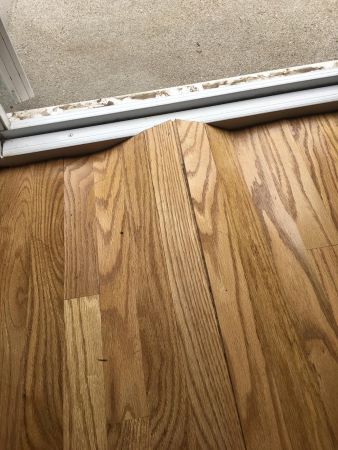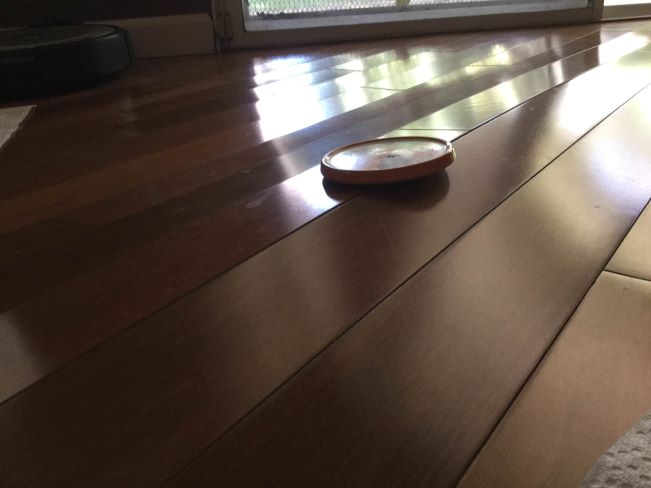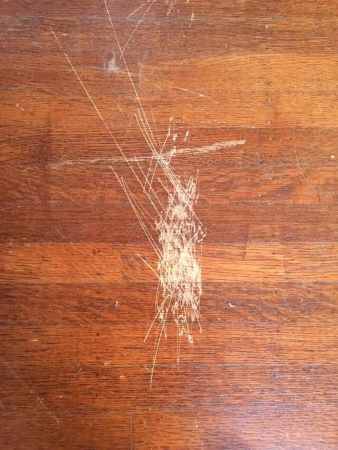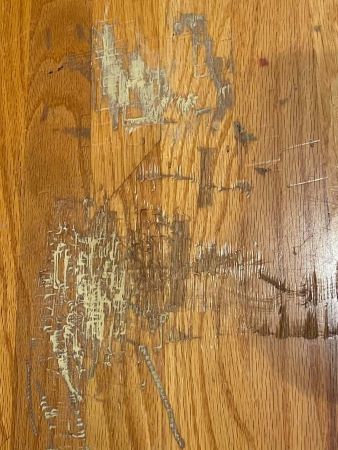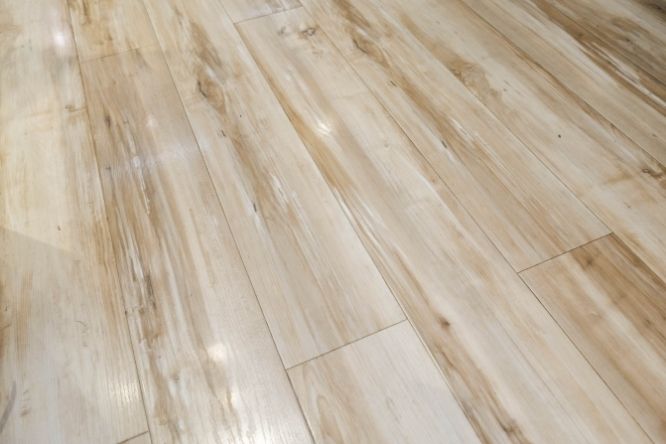If you are shopping for a new hardwood floor for your home, you have probably noticed the options to either “float” or glue down your hardwood flooring.
But how can you tell which one is better for your space? It depends on several factors which we will cover in this guide.
Below you will find a few of the most important advantages and disadvantages for floating vs glue-down wood flooring. At the end of the article, you can find some of the parameters to help you decide which wood floor method is best for you so you can pick the right product.
Floating Wood Flooring
Traditional wood floors are fastened to the subfloor with nails or glue, but a floating wood floor is made up of planks that lock together like a big puzzle using a tongue-and-groove system.
The flooring “floats” because it isn’t attached to the subfloor, but rather uses its own weight and friction to stay in place.
Installing a floating floor consists of preparing the subfloor, laying down a paper-like moisture barrier layer, and locking together the flooring itself.
Since there are little or no fasteners involved, installation is faster and requires a little less technical skill. So floating hardwood flooring lends itself somewhat to DIY or cheaper professional installation.
Advantages of Floating Wood Floors
- Easy to Install – The click-together system makes installing a floating floor quicker and much easier than a glue-down floor. You won’t have to worry about selecting and applying glue or other fasteners, which can be difficult, especially if you want to DIY the floor. Even if your floating flooring requires a little glue on the tongue of each plank, this is faster and easier than gluing the floor down.
- Durable – Hardwood flooring that is designed to float in the room is almost always an engineered material. This means it’s made up of several layers of compressed wood that provide upgraded strength over natural hardwood, especially on the finish.
- Good for Varied Environments – A floating floor leaves a small gap around the edges of the room (which is hidden below the trim). This gap allows the flooring to expand and contract with changing humidity and temperature without causing any problems. If you know you have wide-ranging conditions in your home, floating is a good option.
- Easy to Remove – If you remodel often or are putting flooring in a rental where you think there may be frequent damage, a floating floor can be nice because you can remove a few planks for repairs or remove the entire floor pretty easily. It’s just a matter of unhooking the locking tongues of the boards.
Disadvantages of Floating Wood Floors
- Not as Solid as Glue-Down – There is usually a chance for a slightly soft or hollow feel when you walk on a floating wood floor. This happens because the wide puzzle of interlocked boards can flex slightly underfoot. This is mostly a matter of preference. You might notice light pieces of furniture shift slightly over time, especially if you have kids or dogs running around them every day.
- Not as Stable Under Appliances – Because the floating floor uses its own weight and friction to stay in place, it can cause problems in rooms with heavy appliances (kitchens and laundry rooms). Pushing appliances around could shift the flooring, and the extreme weight could break the locking tongues apart at the edges.
- Needs a Flat Subfloor – If you are putting hardwood flooring in a room with a slope or where the floor is uneven within the room, you might not be able to float the floor. The floating system relies on a flat surface so the flooring doesn’t slide around. Concrete subfloors that are sloped like a ramp or wooden subfloors that have significant high or low spots will cause a problem.
Glue-Down Wood Flooring
A glue-down floor is actually attached to the subfloor. You can think of it as a more permanent option than a floating floor.
These boards will usually still use a tongue-and-groove system, but the boards won’t actually lock together. This system is just to aid in installation and make the floor more stable.
You might spend a little more money on adhesive for this style of hardwood floor than you would spend on the vapor-barrier paper under a floating floor. Installing a glue-down floor definitely requires more technical skill and more time than an equivalent floating floor.
If you want the ultimate stability and strength from your hardwood flooring, a glue-down model is good for you.
Advantages of Glue-Down Wood Floors
- Solid Feeling Underfoot – If you’re concerned about the possibility of a hollow or squishy feeling of a floating hardwood floor, you will probably prefer glued flooring. There will be no room for vibration or shifting between the flooring and the subfloor. Every step will feel solid.
- Good for Uneven or Sloped Rooms – If your home has a hallway that slopes up from one level to another, or if you have a wooden subfloor that has some high or low spots, you need a flooring that will secure directly to the concrete or wood below. This will ensure that the wood does not shift around the room at all.
- Stays In Place – Glue-Down hardwood floors are a good choice for laundry rooms, kitchens, or other rooms where you will be storing heavy objects like appliances. Since every plank is fastened to the subfloor, no amount of weight on top will shift or damage the hardwood.
Disadvantages of Glue-Down Wood Floors
- Difficult to Remove – Because every plank will be glued to the floor with a strong flooring adhesive, removing a glue-down wood floor is difficult. After prying and popping up the boards, you will have to spend hours removing the residue from the subfloor. Do not lay a glue-down hardwood floor that you ever plan to remove.
- Bad for Variable Climates – A hardwood floor that’s fastened with glue will have very limited room to expand and contract when the temperature or humidity vary. Although the glue acts like a moisture barrier to limit these factors, you need to bear in mind that if your house has an extremely unreliable climate, a glue-down floor might not adjust as easily as a floating floor.
- More Difficult to Install – Glue-down floors require an even coat of the right type of flooring adhesive. It takes some skill to apply it properly, and if you make a mistake it is not a very forgiving process. You should probably not attempt a glue-down wood floor DIY project unless you have some experience with troweled adhesives and flooring.
Should I Float or Glue a Wood Floor?
If you are trying to decide which method to choose for your new hardwood floor, you may find the following parameters helpful. They show the advantages and disadvantages from above in action to help you decide which type of flooring is best for your home.
How Level is the Subfloor?
If you have a concrete subfloor that is uneven or sloped, you likely need to install glue-down flooring so that the wood does not slide around or flex under foot. If you have an uneven subfloor that is made of wood, you can install a floating floor only if you first lay down a layer of thin plywood underlayment to correct the subfloor. This can be an expensive extra step.
Are Variable Temperatures and Humidity a Problem?
Floating hardwood floors can expand and contract as one big piece of wood, and the small gap you leave around the walls when you install them will give the flooring somewhere to go when it expands. Glue-down floors, on the other hand, can only handle very slight variations in climate that will cause the wood to expand or contract.
If you know your house has frequent (major) swings in humidity or temperature, choose a floating floor to accommodate this.
Do You Want to DIY?
Floating flooring is quite a bit simpler to install yourself, even if you don’t have flooring experience. You need fewer tools and technical skills than you do to install a glue-down floor.
Which Floor is the Cheapest?
It can be hard to say which option is cheaper. If the conditions are just right for a floating floor (flat and even subfloor), you will probably save money on labor hours and materials since you don’t need to buy glue. However, if your room is going to require a layer of leveling underlayment plywood, the cost of a floating floor may exceed the glue-down option.




